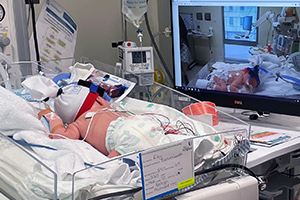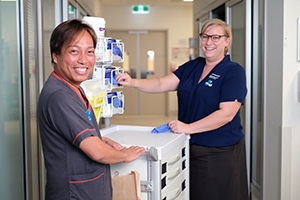Breastfeeding your neonatal baby
Babies who are born small, premature or sick are cared for in our Neonatal Unit at Fiona Stanley Hospital.
We encourage mothers of neonatal babies to start expressing breastmilk as soon as possible after giving birth (ideally within the first hour after birth). Although these babies may initially be unable to breastfeed, they can be fed their mother’s expressed breastmilk (EBM) through other feeding techniques.
Breastfeeding offers many benefits to newborn babies, including:
- meeting all their nutritional needs
- increasing their ability to fight infection and disease
- helping them build a close and loving bond with their mother.
Expressed breastmilk is gained when a mother releases breastmilk by using her hands or a pump. For premature or sick babies who cannot breastfeed, this expressed breastmilk is then fed to the baby through either of the following methods:
- A nasogastric tube (NGT) is a thin, flexible tube which is gently inserted through a baby's nose and down into their stomach. This tube is used to give your baby food and medicine, or to remove air or fluid from their stomach.
- An orogastric tube (OGT) is a thin, flexible tube which is gently inserted through a baby's mouth and down into the stomach.
Both tubes help ensure your baby gets the nutrition and care they need while they are in the neonatal unit.
Please be assured our neonatal staff will show you how to feed your expressed breastmilk to your baby and offer you the support you need.
Mothers who start expressing within the first 1 to 2 hours after birth are more likely to achieve adequate milk production. Studies show early expression can lead to a 50 per cent increase in milk volume compared to those who start later.
Contact us
Fiona Stanley Hospital Neonatal Unit (3B) patients can phone the:
- Neonatal Unit on 6152 0215, 24 hours a day, 7 days a week
- Fiona Stanley Hospital Lactation Consultant on 0403 137 964 between:
- 8:00am to 4:00pm, Monday to Friday
- 8:00am to 2:00pm, Saturday and Sunday.
Find out more
- Learn more about you and your baby's neonatal journey.
- Find your closest private lactation consultant
- Find your local child health centre (external site)
- Australian Breastfeeding Association (external site)
Available 24 hours a day, 7 days a week
Phone the Helpline on 1800 686 268 - Ngala (external site)
Phone the Ngala Parenting Line on 9368 9368
Outside the metropolitan area, free call 1800 111 546 (free from land line only), 8.00am to 8.00pm, 7 days a week




